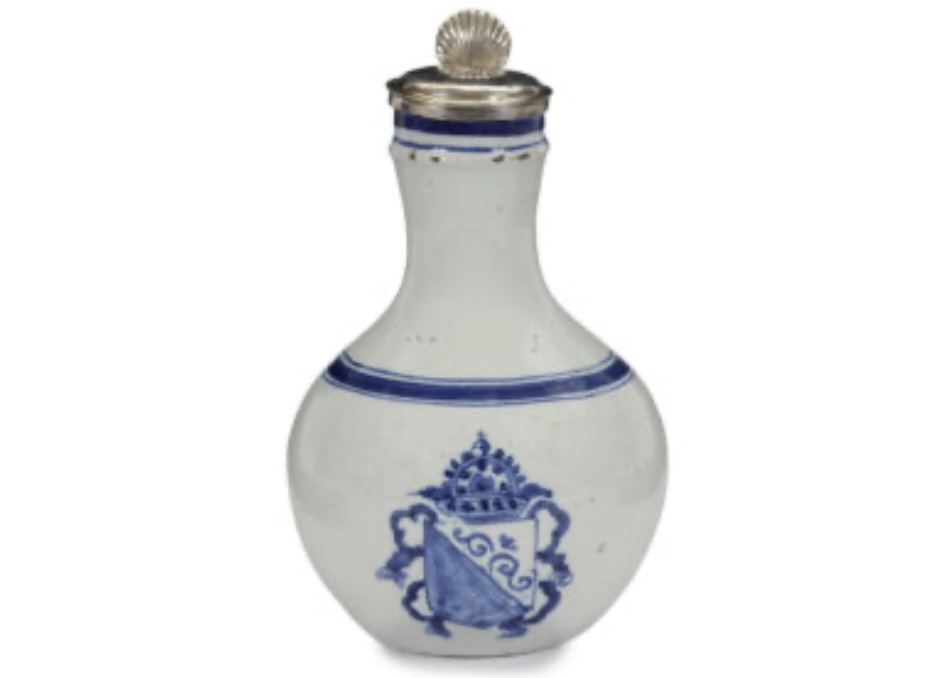
The History of Armorial Delftware
Armorial Delftware, like other heraldic objects, has long captivated the interest of collectors and historians. The coats of arms on these objects often provide clues about their origin, the families or institutions that commissioned them, and the time period in which they were created. In this article, we explore the rich history of heraldry and its diverse representation on Delftware.
A Short History of Heraldry
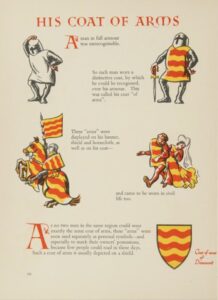
A coat of arms has been a distinctive symbol since the Middle Ages. It became necessary for knights to bear recognizable symbols on their shields with the use of heavy armor and closed helmets (fig. 1). These symbols took on broader significance and began to appear on documents, buildings and banners.(1) A culture around heraldry eventually developed, in which the rules and customs for designing coats of arms were established.
Originally, coats of arms were unique to each knight, but later, sons often adopted their father’s coat of arms, leading to the concept of the family coat of arms.(2) In the Netherlands, noble family coats of arms are protected and registered by the High Council of Nobility. Although anyone can register a coat of arms, the design must adhere to the rules of heraldry.
Coats of arms were first used in Dutch cities in the late twelfth and thirteenth centuries.(3) A recognizable coat of arms served practical purposes, such as a trademark or seal of authenticity. For instance, ‘lakenloodjes’, small lead seals, were used to certify the quality and origin of textiles, while silver hallmarks often incorporated city coats of arms early on to trace the silver’s origin. For example, Delft’s oldest known seal, bearing a version of its coat of arms, dates back to 1260, though it differs from the modern emblem.(4) Amsterdam appears to have been later in developing its coat of arms, as there is no concrete evidence of its existence in the thirteenth century. However, archaeological findings suggest that it was in use by at least the fourteenth century.(5)
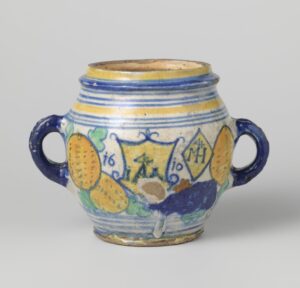
The custom of depicting city coats of arms on ceramics emerged in the late medieval and Renaissance periods. This gradually expanded to include private commissions for family armorial wares. Spanish lustreware and Italian maiolica were among the first to incorporate coats of arms, sparking a long tradition of armorial ceramics.(6) In the Netherlands it became especially popular on maiolica during the sixteenth and seventeenth centuries, when coats of arms began to feature prominently on items such as tiles, plates, and dishes. In the Netherlands, the heraldry of prosperous trade cities, such as Amsterdam and Haarlem, was often displayed.(7) A notable example is a 1610 majolica jug featuring the coats of arms of both cities (Fig. 2).
In the early seventeenth century, Portugal, like the Netherlands, was producing earthenware that imitated Chinese porcelain. These pieces, decorated with fictional coats of arms, were specifically crafted for the Dutch and German markets. The Delft pottery industry later entered this market.(8) As leading pottery producers of their time, Delft potters played a crucial role in the production of armorial wares, significantly contributing to its development and widespread popularity in the Netherlands. This tradition was closely tied to the rise of civic pride and the growing influence of cities in Europe. The city coat of arms no longer functioned primarily as a quality guarantee, but also a symbol of civic pride and status.(9)
While there is limited documentation on the primary patrons and the use of armorial ceramics, it is likely that, alongside private citizens and entrepreneurs, government officials and royals were key clients for these items. Particularly noteworthy is the role of King William III and Queen Mary II, who can be regarded as royal ambassadors for Delft ceramics during their English period. The significant number of surviving pieces of armorial Delftware from the late seventeenth century, bearing their coat of arms or monograms, often alongside those of prominent statesmen or high-ranking officials, suggests that these ceramics were frequently given as diplomatic gifts.(10) Such pieces were used to express royal appreciation and served as a cherished means for individuals to demonstrate their loyalty to the monarchy. These examples highlight the close connection between Delft pottery and the royal court, emphasizing its importance as both a symbol of power and a tool for diplomacy.
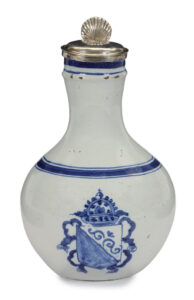
In the wake of the royal couple, the public and governmental elite ordered Delft armorial wares as well. During the seventeenth and eighteenth centuries, city governments often supported local industries by commissioning artisans for various projects. In Delft, it is highly likely that they played a role in commissioning high-quality ceramics for official celebrations, diplomatic gifts, and for use in both public and private buildings. Armorial items, in particular, likely symbolized the wealth and status of the city and its leaders. A notable example is an armorial jug from around 1650, bearing the coat of arms of Utrecht (fig. 3). This jug belongs to a small series of similar items bearing the coats of arms of Delft and Amsterdam, suggesting they were part of a limited commission for a special occasion, possibly ordered by city officials.(11)
The next example is not made of ceramic, however it illustrates that city governments were commissioning such items by the sixteenth century. In 1574, the city council of Nijmegen tasked pewter caster Gerrit de Leeuw with producing eighteen ‘stadskannen‘ (city jugs).(12) These jugs were created by melting down the ones originally made about 30 years earlier for Emperor Charles V’s visit to Nijmegen. This shows how city administrations often played a direct role in commissioning ceremonial items for important occasions or dignitary visits.(13) ‘Stadskannen’, were generally much larger than the Utrecht jug, holding several liters and designed for grand occasions with large gatherings. In contrast, the Utrecht jug is more modest in size, suggesting it may have been intended for a smaller group or possibly given as a gift to an individual.
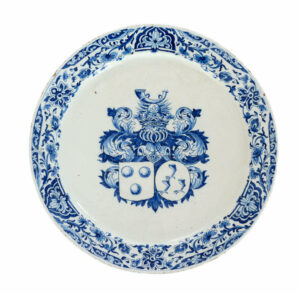
each marked LVE in blue for Lambertus van Eenhoorn, the owner of De Metaale Pot (The Metal Pot) factory from 1691 to 1721, Aronson Collection D2011
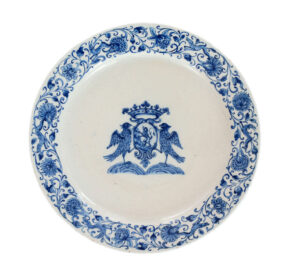
Armorial ceramics, found in both museum and private collections, encompass a wide range of objects, from practical items like plates and jugs to more decorative pieces such as tiles and large wall plaques. These pieces were highly valued by the elite, who frequently commissioned them for private events, such as weddings, or for purely ornamental purposes. An early example of armorial faience is seen in two similar plates made for Danish nobleman Werner Klouman, featuring his coat of arms and dated 1648.(14) They provide clear evidence that armorial Delft ceramics were already being produced in the first half of the seventeenth century, and together with the other examples found abroad, underscoring the wide-reaching reputation of Dutch craftsmanship.
Heraldic Delftware became increasingly popular from the last quarter of the seventeenth century through the eighteenth century. As mentioned in our previous article on the ‘De Ramaix’ collection, armorial Delftware became also highly collectible, continuing to attract interest to this day. Alongside many other collectors, the Van der Vorm family incorporated armorial wares into their collection, further contributing to the preservation of this tradition. Their collection included several armorial sets, some of which have additional pieces known to exist in other collections (Fig. 4-5). These examples highlight that even occasion-specific ceramics could be produced in larger quantities. It is possible that these pieces were intended for distribution among family members or as part of larger dinner sets, though this remains speculative.
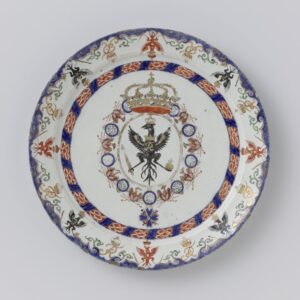
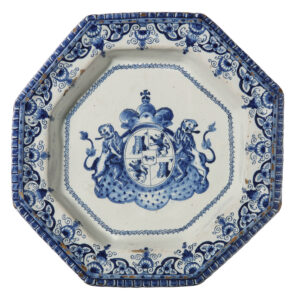
Factories that were particularly active in the production of armorial ware for both the domestic and foreign markets, included ‘De Grieksche A’ (The Greek A). Beside from royals William and Mary, they received numerous other royal commissions, including from King Frederick I of Prussia. Shortly after his coronation and despite Berlin having its own faience factory and a ban on importing Delftware, he commissioned a royal dinner set and wall appliques from Delft (Fig. 6).(15) Among the impressive legacy of ‘De Metaale Pot’ (The Metal Pot) are plates made for Emperor Carl VI (1685-1740) with the Habsburg double eagle, produced during the ownership of Lambertus van Eenhoorn.(16) Another remarkable commission can be found in a large dinner set for the German-Italian Thurn and Taxis Family (Fig. 7). Nowadays two surviving pieces from this set are known.
‘De Witte Ster’ (The White Star) was another important player in the market for armorial ware, also working for royals.(17) Their armorial legacy includes a variety of items such as plates, plaques and flower pyramids. (18) A spectacular example is an oval plaque depicting the coats of arms of the Specx and the Van Eijck families (Fig. 8).
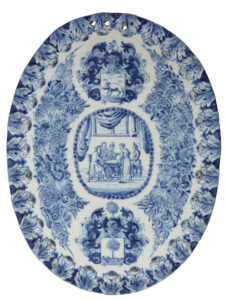
In conclusion, armorial Delftware played a significant role in European heraldic traditions, symbolizing power, wealth, and civic pride. Commissioned by royalty, city governments, and private individuals, these ceramics served as diplomatic gifts and ornamental pieces. The legacy of Delft armorial ceramics continues to captivate collectors and historians alike, reflecting the long-standing tradition of combining art, heraldry and function.
Notes
- Iain Moncreiffe and Don Pottinger, Simple Heraldry, Edinburgh and London, John Bartholomew and Son Limited, 1978, p. 10.
- Eva Ströber, ‘Friesland schotel, made in China’, published on: https://www.princessehof.nl/collectie/azi%C3%AB/frieslandschotel
- Joost C.M. Cox, ‘Repertorium van de Stadsrechten in Nederland’, Oisterwijk, 2012
- Idem, p. 41
- Evidenced by a marking pliers, dating from 1330-1360, found during archeological excavations in Amsterdam described and depicted in: Peter Kranendonk, Wiard Krook and Arno van den Brand, ‘Het Amsterdamse stadswapen. Afbeeldingen op opgegraven veertiende-eeuwse textielloden’ in: ‘Monumenten & Archeologie I’, Uitgeverij Bas Lubberhuizen, 2002, p. 44
- Aronson Antiquairs, ‘Wapengoet’: Armorial Wares’ published on: https://www.aronson.com/wapengoet-armorial-wares/ and A. van de Put, Hispano-Moresque Ware of the XV Century, London, 1904, many fifteenth century examples of armorial wares are depicted.
- Several examples are depicted in Dingeman Korf, Nederlandse Majolica’, 1973, p. 32 and pp. 106-107. An example of a 1572 dated Majolica plate with the coat of arms of Amsterdam is depicted in L.M.C. de Nas, Zijn Dateringen “uit de tijd” in: ‘Tegel 21′, 1993, p. 48
- Kristin Duysters, ‘De keramiekverzamelaar W.F.K. baron van Verschuer’, in: Vormen uit Vuur No. 229, 2015/3, p. 85
- Eva Ströber, Friesland schotel, made in China, published on: https://www.princessehof.nl/collectie/azi%C3%AB/frieslandschotel
- In chapter six of Suzanne Lambooy, ‘Koninklijk Blauw’, Zwolle/Den Haag, 2020, multiple examples of Delftware are described and illustrated. One notable piece is a large pot featuring the coat of arms of Peter Craegh (1642-1705) on the front and the monogram of William and Mary on the reverse.
- An identical jug, featuring the coat of arms of Amsterdam, is part of the collection at the Amsterdam Museum – Willet Holthuysen (inv. nr. KA 7847). A similar jug, displaying the coat of arms of Delft and sourced from the collection of the Rijksmuseum, Amsterdam (inventory number BK-NM-2104), is illustrated in Van Aken-Fehmers, 2013, page 28. Another example, adorned with the coat of arms of Amsterdam, can be found in the collection of Kunstmuseum The Hague.
- Yvette Driever, ‘De laatste Stadskan?‘, in: ‘Rembrandt Bulletin’, jaargang 31, 2021, No. 1, p. 51
- Idem
- Jan Daan van Dam, ‘Geleyersgoet en Hollants Porceleyn. Ontwikkelingen in de Nederlandse Aardewerk Industrie 1560-1660‘ in: ‘Mededelingenblad Nederlandse vereniging van Vrienden van de Ceramiek’, No. 108, 1982/4, p. 63. One example is in the Bymuseet in Copenhagen, the other in the Aronson Collection.
- A remain of this set is a dinner plate in the collection of the Rijksmuseum, Amsterdam with inv. nr. BK-1963-45. Also see Van Dam, 2004, p. 125
- https://www.aronson.com/wapengoet-armorial-wares/
- Some examples made in ‘De Grieksche A’ and ‘De Witte Ster’, can be found in Suzanne Lambooy, ‘Koninklijk Blauw’, 2020, p. 160.
- The Aronson Collection includes several armorial pieces marked for ‘De Witte Ster’, such as D1244 and D2424
Literatuur
Van Aken-Fehmers, ‘Delft White, not just Blue’, Waanders Uitgevers, 2013
Cox, Joost C.M. ‘Repertorium van de Stadsrechten in Nederland’, Oisterwijk, 2012
Dam, J.D. van, ‘Geleyersgoet en Hollants Porceleyn. Ontwikkelingen in de Nederlandse Aardewerk Industrie 1560-1660)’ in: ‘Mededelingenblad Nederlandse vereniging van Vrienden van de Ceramiek’, No. 108, 1982/4
Dam, J.D. van, ‘Delffse Porceleyne, Dutch Delftware 1620-1850′, Zwolle/Amsterdam (Rijksmuseum), 2004
Driever, Yvette, ‘De laatste Stadskan?’, in: ‘Rembrandt Bulletin’, jaargang 31, 2021, No. 1
Duysters, Kristin, ‘De keramiekverzamelaar W.F.K. baron van Verschuer’, in: ‘Vormen uit Vuur’ No. 229, 2015/3
Hudig, F, ‘Wapengoet en Porceleyn’ in: ‘Oud Holland’, Vol 43, 1926
Kleyn, de J., ‘Een blauw en wit Delftse schotel van omstreeks 1700 met de familiewapens van een Arnhems echtpaar’, in: ‘Antiek’, March 1970
Suzanne Lambooy, ‘Koninklijk Blauw’, Zwolle/Den Haag, 2020
Peter Kranendonk, Wiard Krook and Arno van den Brand, ‘Het Amsterdamse stadswapen. Afbeeldingen op opgegraven veertiende-eeuwse textielloden’ in: Monumenten & Archeologie I, Publisher Bas Lubberhuizen, 2002
Moncreiffe, Iain and Don Pottinger, ‘Simple Heraldry’, Edinburgh and London, John Bartholomew and Son Limited, 1978
Put, A van de, ‘Hispano-Moresque Ware of the XV Century’, London, 1904
Ströber, Eva, ‘Friesland schotel, made in China’, published on: https://www.princessehof.nl/collectie/azi%C3%AB/frieslandschotel
Vigelius, Matty F. ‘Wapengoet’, in: ‘Elseviers Geïllustreerd maandtijdschrift’, Jaargang 42, 1932



